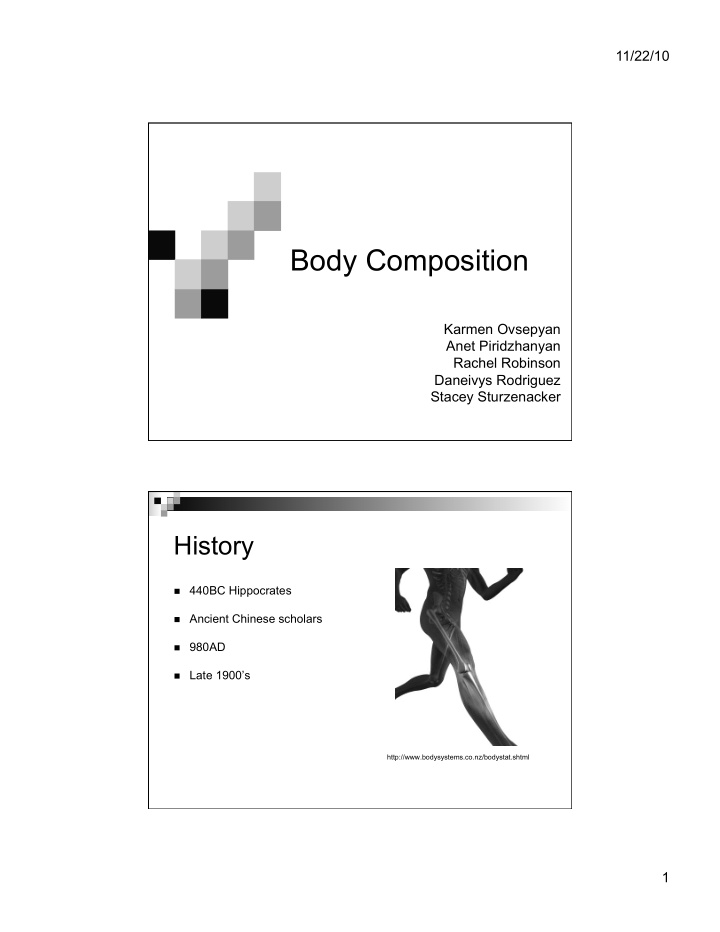



11/22/10 Body Composition Karmen Ovsepyan Anet Piridzhanyan Rachel Robinson Daneivys Rodriguez Stacey Sturzenacker History 440BC Hippocrates Ancient Chinese scholars 980AD Late 1900’s http://www.bodysystems.co.nz/bodystat.shtml 1
11/22/10 Body Composition http://www.exercisebiology.com/index.php/site/articles/ which_is_the_most_accurate_body_fat_measurement_method_calculator/ Lean Build vs. Non-Lean Build Aesthetic and weight dependent Non-weight dependent Sports Sports Tennis Cross-country Volleyball Track Basketball Swimming Soccer Body builders Hockey Wrestling/Boxing Lacrosse Dance/Ballet Field events from Track and Field Nichols, J.F., Rauh, M.J., Barrack, M.T., Barkai, H., & Pernick, Y. (2010). Disordered eaBng and menstrual irregularity in high school athletes in lean‐build and nonlean‐build sports. Interna'onal Journal of Sport Nutri'on and Exercise Metabolism, 17, 364‐377. www.livestrong.com 2
11/22/10 Analyzing Body Composition and Assessing Weight Physical measurements: Important for assessment of progress to achieve peak performance. -Height -Weight -Somatotype -Girth -Body Composition http://www.witweightloss.com/ Height & Weight Height (stature) & weight (body mass) -optimal weight is relative to height For accurate measurements: - measurement boards -calibrated scales Imagegs taken from: http://www.womansday.com/var/ezflow_site/storage/images/media/galleries-slideshows/_image.jpg http://www.quickmedical.com/images/sku/tnails_250/78.jpg 3
11/22/10 Somatotype (Body Build) Endomorph -stocky, gain fat easily Mesomorph -muscular, do not gain large amounts of fat Ectomorph -minor, small amounts of fat and muscle Imagine taken from:http://www.pponline.co.uk/encyc/img/251Bfig1.png Girth Circumference of different body parts -waist, hips, calves, thighs, arms, chest. Helps track changes in body size Images taken from: http://www.topendsports.com/testing/images/girth-hip.jpg 4
11/22/10 Tools To Assess Body Composition Near-infrared interactance (NIR) Biolectrical impedance (BIA) Skinfold thickness Body plethysmography (Bod Pod) Hydrostatic (underwater) weighing Dual-energy X-ray absorptiometry (DEXA or DXA) Tools To Assess Body Composition Image taken from: http:// Image taken from: http://i2.cdn.turner.com/cnn/ s1.hubimg.com/u/ https://teach.lanecc.edu/naylore/225lectures/09a/ 2009/HEALTH/01/02/ 1136328_f260.jpg thumbnails/09omronhandheldimpedence.jpg healthmag.measuring.body.fat/ art.calipers.arm.gi.jpg Images taken from: http:// www.ori.org/healthyweight/ Image taken from: http:// images/bodpod.jpg www.livebetterwiki.com/Portals/ Image taken from: http:// 0/underwater%20weighing.jpg www.tappmedical.com/ page_images/dexa.jpg 5
11/22/10 Weight Maintenance Athletes can face unwanted weight gain/weight loss Focus on a time in the pass when weight was maintained Periodization Change of training and competition season May increase or decrease nutrient needs Injuries and Off Season Weight Reduction Identify an Appropriate Weight Range Evaluate Current Dietary and Exercise Practices Establish Energy and Macronutrient Requirements Devise a Dietary Plan for Achieving Goals on Established Needs Educate the Athlete; Review the Dietary Plan, Monitor Status 6
11/22/10 Weight Gain Gaining body weight requires consistent excess energy intake Gain lean weight or muscle mass Increase Carbohydrates, Proteins, and Fats Similar five steps from Weight Reduction Four steps to achieving optimal performance weight 1. Assessment 2. Goal Setting 3. Action Plan 4. Evaluation and Reassessment http://www.behaviortherapyassociates.com/ histepsummersocialskillsprogramnewjersey. html 7
11/22/10 Gain Muscle, Lose Excess Fat hNp://1.bp.blogspot.com/ _3yPf33hffzs/S_K0IKt0FqI/ AAAAAAAAA0I/ 1nnqeoWeTP0/s1600/ weight‐li\ing‐for‐women.jpg In order to do this recommendations are: Aerobic activity Resistance Training keeps fat off and increases muscle mass Aerobic workouts and weight training along with proper nutrition enables an athlete to get their desired body composition More Protein? Do athletes need excess protein to build muscle? Do not need excessive amounts of protein No benefits from excess protein Lower carbohydrate intake Excessive caloric intake Greater fluid losses Higher food costs 8
11/22/10 HET http://www.google.com/imgres?imgurl=http://www.embracethefuture.org.au/resiliency/images/ecological-diagram.gif&imgrefurl=http:// www.model9489.net/ralph-lauren-male model.html&usg=__Pygr8lyr4GI2cVsTCZIdeXOhRYE=&h=420&w=440&sz=24&hl=en&start=0&zoom=1&tbnid=lHAxJmIgCVzPKM:&tbnh =136&tbnw=142&prev=/images%3Fq%3Dhuman%2Becological%2Btheory%2Bmodel%26um%3D1%26hl%3Den%26biw %3D1259%26bih%3D658%26tbs%3Disch: 1&um=1&itbs=1&iact=hc&vpx=402&vpy=170&dur=22&hovh=219&hovw=230&tx=138&ty=136&ei=DW3pTLeSK5KisQOkpdGwCw&oei= DW3pTLeSK5KisQOkpdGwCw&esq=1&page=1&ndsp=19&ved=1t:429,r:2,s:0 Articles 9
11/22/10 Body composition assessment in athletes with spinal cord injury: comparison of field methods with dual-energy X-ray absorptiometry Mojtahedi, M., Valentine, R., & Evans, E. (2009). Body composition assessment in athletes with spinal cord injury: comparison of field methods with dual-energy X-ray absorptiometry. Spinal Cord , 47 (9), 698-704. Retrieved from http://libproxy.csun.edu/login? url=http://search.ebscohost.com/ login.aspx? direct=true&db=rzh&AN=20103988 78&site=ehost-live http://seriousaccidents.com/spinal-cord-paralysis-injury/paralysisinjury- blog/paralyzed-celebrities/paralympians-25-years- fundraising-spinal-cord- injury-research/ Purpose Purpose of the study was to compare estimates of body fat % from SKF and BIA with the DXA estimates in athletes who have spinal chord injury. 10
11/22/10 Methods (Participants) 16 Caucasian athletes with SCI 8 women & 8 men 12 wheelchair basketball & 4 wheelchair racing programs. 11 complete SCI & 5 incomplete SCI Methods (Procedures) No alcohol No exercise 16hr before testing Empty bladder Women: during days 7-14 from start of last menstrual period Anthropometric & BIA measured during morning after 12 hr fasting 11
11/22/10 Methods (Procedures cont.) Anthropometry SKF BIA Compared to DXA Statistical analyses Results/Conclusions Men taller & weighed more than Women Women had greater %Fat than men %Body Fat for the BIA equations were closer to DXA %Body Fat than SKF estimates for both men and women Believe neither measurements accurately estimate %Body Fat 12
11/22/10 Relationship between body composition, leg strength, anaerobic power, and on-ice skating performance in division I men’s hockey athletes Potteiger, J.A., Smith, D.L., Maier, M.L. & Foster, T.S. (2010). Relationship between body composition, leg strength, anaerobic power, and on-ice skating performance in division I men’s hockey athletes. Journal of Strength and Conditioning Research, 24(7), 1755-1762. www.bluestreakst.com Purpose To examine relationships between laboratory tests and on-ice skating performance in division I men’s hockey athletes. 13
11/22/10 Methods 21 men (age 20.7 ± 1.6 years Assessed body comp., isokinetic force production in quadriceps and hamstring muscles, and anaerobic muscle power (AMP) Air displacement plethysmography (% body fat) Wingate 30-second cycle ergometer test (AMP) On-ice skating performance measured during 6 timed 89-m sprints Subjects wore full hockey equipment www.yorkblog.com Results: %Fat 11.9 ± 4.6 Avg. skating times were moderately correlated to %Fat Greater %Fat => slower skating speeds Faster speeds correlated with Wingate Fatigue index Conclusions: Laboratory testing of select variables can predict skating performance in ice hockey athletes. Info used to develop targeted and effective strength and conditioning programs to improve skating speed www.yorkblog.com 14
11/22/10 Dietary Intake and Body Composition of Prepubescent Female Aesthetic Athletes Soric,M., Misigoj- Durakovic, M., & Pedisic, Z. (2008). Dietary intake and body composition of prepubescent female aesthetic athletes. Journal of Sports Nutrition and Exercise Metabolism,8 , 343-354. http://www.mp3runningworkouts.com/wp-content/uploads/2010/02/ article_image_Athlete_Nutrition.jpg Purpose To assess energy and nutrient intakes in prepubescent athletes practicing different aesthetic sport disciplines as well as to assess possible differences that there might be between these groups of athletes. 15
Recommend
More recommend